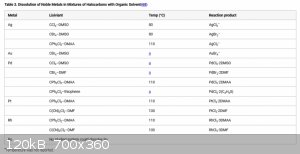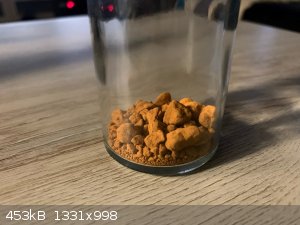woelen
Super Administrator
        
Posts: 7977
Registered: 20-8-2005
Location: Netherlands
Member Is Offline
Mood: interested
|
|
separation of gold from dental crowns
I had two dental crowns, and I added the metal from these to aqua regia (made by mixing 4 parts of conc. HCl with one part of 90% HNO3, home
distilled). I first hammered the crowns to get rid of remnants of teeth or glue. These crowns dissolved slowly, leaving a white solid ceramic looking
material behind.
I read that dental crowns are mostly gold, but also contain silver, palladium, platinum and some other less noble metals. I think that the silver
contents causes the formation of the ceramic looking remains (formation of AgCl, which does not dissolve in the acid) and all other metals go in
solution. The solution I have now is very dark red with a brown tinge.
My greatest concern is the presence of the platinum and palladium. The amount only is small, maybe a percent or 2, but it may spoil the gold a lot. I
took a single drop of the dark red solution, added this to 20% HCl. This gives a yellow solution, with a slight brown tinge (the solution looks like
urine). To this I added Na2SO3, and this leads to formation of a brown/ochre very fine precipitate, which fairly quickly settles at the bottom. Is
this gold? And does the platinum and palladium settle as well? The latter would be bad, because it makes the gold impure.
Has anyone experience with purifying gold from dental crowns? I do not need to collect any of the other metals, I want just the gold.
|
|
|
vano
National Hazard
   
Posts: 661
Registered: 22-3-2019
Location: Georgia
Member Is Offline
|
|
I don't have experience with mentioned situation, but I remembered this video:
https://www.youtube.com/watch?v=W3bkIkIKKEs
|
|
|
woelen
Super Administrator
        
Posts: 7977
Registered: 20-8-2005
Location: Netherlands
Member Is Offline
Mood: interested
|
|
I had two dental crowns, total weight appr. 5 grams. So, I expect to get around 3 grams of gold. I will not melt the gold, I want it in a very finely
divided state, for experimenting. In the video, he uses oxalic acid as reductor. That I'll do as well, leaving any palladium and platinum in solution.
I will not take any effort (and cost) to regain the palladium and platinum, those simply are too small amounts to be useful. Silver also is not that
interesting, at the current price of just $0,70 per gram. I can easily buy a 1 oz bullion for 25 euros or so of 99.99% silver, so it's not worth the
hassle to regain a gram of silver from the dental crowns.
|
|
|
vano
National Hazard
   
Posts: 661
Registered: 22-3-2019
Location: Georgia
Member Is Offline
|
|
I have always been interested in dissolving precious metals in organic solvents or melting aluminum nitrate and chloride mixture. You can try a small
amount. I tryed organic solvents method on copper and it's works.

|
|
|
AJKOER
Radically Dubious
    
Posts: 3026
Registered: 7-5-2011
Member Is Offline
Mood: No Mood
|
|
Depending on the age of the crown (more likely its relationship to the metal's market price existing around that time), one could have more metals in
the alloy. To quote a source https://www.intechopen.com/chapters/41216 :
"There is a wide variety of dental alloys, ranging from nearly pure gold and conventional gold-based alloys to alloys based on silver, palladium,
nickel, cobalt, iron, titanium, tin, and other metals (Table 1). The types of dental alloys have increased significantly since 1980s in order to
change the market price of gold and palladium. Although gold alloys are the materials of choice in this area because of their high mechanical
properties, good corrosion resistance and excellent biocompatibility, their price still poses the essential challenge to dentistry. So that,
alternative materials such as Ag-Pd alloys, Co-Cr alloys and Ti alloys have been introduced into dentistry [1,2]."
The presence of possible more metals increases the complexity and may be responsible for unexpected array of colors.
|
|
|
S.C. Wack
bibliomaster
    
Posts: 2419
Registered: 7-5-2004
Location: Cornworld, Central USA
Member Is Offline
Mood: Enhanced
|
|
Attn morgue employees and graverobbers: read Brauer.
|
|
|
Quiklearner
Harmless

Posts: 3
Registered: 12-12-2018
Member Is Offline
|
|
Try to get everything in solution, dilute and cool it, destroy any excess nitric acid using SULFAMIC acid, filter out silver chloride and then use
Ferrous Sulphate to precipitate the gold. Lots of info on the Gold Refiner's Forum.
|
|
|
woelen
Super Administrator
        
Posts: 7977
Registered: 20-8-2005
Location: Netherlands
Member Is Offline
Mood: interested
|
|
Thanks for the info. I have a lot of sulfamic acid, so that can be put to good use.
One thing, which I do not want to do is melting the gold for purification. I do not have the equipment to melt it and without proper equipment, that
is too risky.
If I get the powdery precipitate with the ferrous sulfate, is it of decent purity?
|
|
|
Quiklearner
Harmless

Posts: 3
Registered: 12-12-2018
Member Is Offline
|
|
The net result is you will end up with a precipitate of high purity IF you properly neutralize all the excess nitric acid.
The remaining solution will contain PGMs and any base metals present in the crowns. This solution is highly toxic and should be placed in a
"stock-pot" containing copper to "cement" PGMs out of solution as a fine black "mud".
You can re-refine the resulting gold powder from the ferrous sulphate precipitation using aqua regia and then use a different precipitant such as
sodium metabisulphite to reach even higher purity.
Suggestion: Do not premix your aqua regia. Start by adding HCL and then use a pipette to incrementally add small doses of nitric acid while waiting
for the reaction to die down somewhat between doses to avoid a boilover (especially when re-refining finely divided material).
Things to strive toward: KEEP YOUR WASTE TO A MINIMUM and consider the proper treatment of said waste as a requirement of doing these things.
Oh, and don't breath any of the fumes!!!
If I can figure out how, I will post a picture of the results I achieved when doing the same.
|
|
|
Quiklearner
Harmless

Posts: 3
Registered: 12-12-2018
Member Is Offline
|
|
Well, I figured it out...
This picture is what I produced using the methods I found on the GRF. I highly recommend you research there. Many very knowledgeable and experienced
refiners on there. MUCH more so than I.

|
|
|
Rainwater
National Hazard
   
Posts: 799
Registered: 22-12-2021
Member Is Offline
Mood: indisposition to activity
|
|
Safety warnings can be found on the Darwin awards website.
Stannous chloride solution would be of great help to you. It's the go-to standard for determining what you have in solution. The problem with going
straight to AR is that you bring everything into solution(mostly)
Some will get trapped into the silver chloride that forms and not enter into the reactions.
Some elements don't react with AR
Without ever melting anything, it presents the real challenge here.
Selective precipitation is a must.
If you could melt everything and alloy the sample this would be a lot easier.
I recommend placing your sample into a volume of hcl(aq) then slowly adding nitric acid. That way excess nitric acid does not require
naturalization latter.
If you added to much, the cheapest method to remove it is to boil it off. Try to get the mixture to 120c. Depending on how much excess nitric you
have, it will not reach this temperature. When the solution boils between 100-104c. Your nictric excess has been removed. As well as a lot of your
hcl.
Any nitric acid in solution will spoil the next step!!
Filter the solution amd remove any solids.
Then start adding SMB 1~4 grams at a time (sodium metabisulfite) to your solution, you will notice a small amount of gas produced.
When you reach the sweet spot, a lot of gas and foam will be produced.
Wait until the foam has stopped, and the layers start separating.
Then, perform a stannous test. If their is a black/blue color change after 5 minutes, you still have gold in solution. Add more smb then repeat.
Different metals will give you different colors on your stannous test
Black/blue means gold.
Now filter your solution and mail the percipitate to me. Its dangerous and known to cause leprechauns to do mean things.
What your left with is a 95+% gold sponge.
Quiklearner is right about disposal and toxicity.
If you want a more pure sample.
Plage the sponge into a hot hno3 bath. ~100c with stiring. For about 30 minutes.
If you see any orange gas or color in your solution. Keep it on heat until the gas is gone. Decant then repeat until you have no effect on your
solution.
Then AR and percipitate again.
This will being your purity to 99+%
If you alloy your sample with copper or silver then you can remove the base metals before the AR treatment saving you a step.
4 9's fine(99.9999%) can be obtained by reducing your last AR solution to almost dryness.
Mixing with distilled water and performing electrolysis.
"You can't do that" - challenge accepted
|
|
|